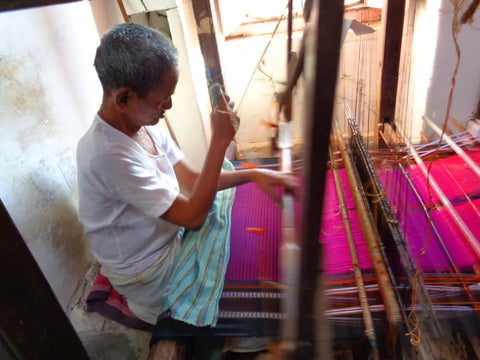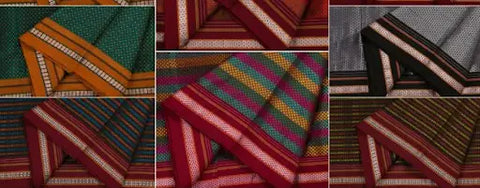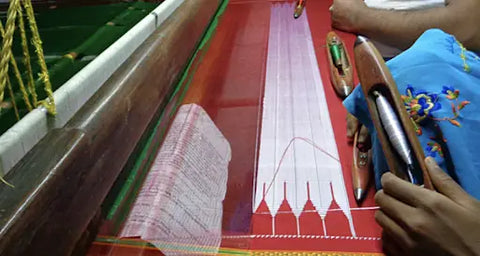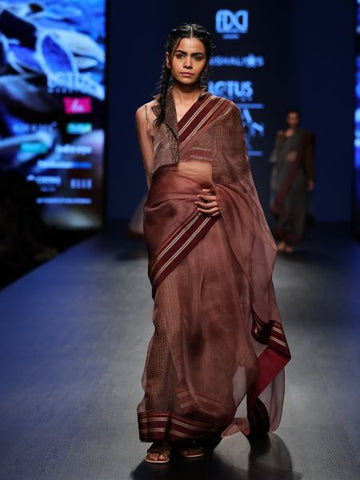Introducing the art of Khun Weaving:
Khun weaving, is also known as Dharwad khun, or khana, and is native to the Bagalkot district of the state of Karnataka, India. Traditionally, and generationally, it has been donned by the native women of the northern regions of the state, and some parts of the Vidarbha and Marathwada regions of Maharashtra. The weaving style and intricate brocade pattern were founded over 4000 years back, and are accentuated with delicate and small motif designs. The main characteristic of this which makes it easily distinguishable is the purple-reddish border of these fabrics. It is an elegant and intricate form of weaving that brings a look of simplicity, but beauty, to the fabrics that go under the weave, and is one of the central sources of livelihood to the weavers that indulge in these workings. 
Details of Khun weaving and the craft:
History:
Research done by esteemed organizations based on their interest, such as the Isha foundation, presumed to have originated in the period of the Chalukya Dynasty, in the 8th century, by the folklore, Khun was introduced when the ruling power was at its highest in the country, and had since then been continued by the weavers. Much like other old traditions of the past, Khun weaving was soon lost in a world of modernity and fast changing times. Many years later, it was founded again in the village of Gulegudda. Weavers started taking up this weave pattern to accompany it with the Ilkal sarees. The patrons of the village often offered up these pieces of fabric by folding them into triangles to the goddesses, and this was a tradition. Most of the designs and motifs that are etched onto the fabric are inspired from nature.
Region:
As aforementioned, the fabric was the staple product of the village of Gulegudda, of Bagalkote district of Karnataka, and found patronage in certain parts of Maharashtra as well.
“Until the 1990s, Guledagudda was known as one of the highest tax-paying towns, only by the sale of khun fabric. For generations, the only occupation the residents knew was weaving. With modern dressing and lifestyle changes, khun fabric lost its market and Guledagudda its source of revenue”, The Wire.
Process:
The yarn that is used for the weaving process is first dyed, in the required color or color in the choice of the weaver. After the dyeing process is completed, the yarn is then wrung out, to give the color time to settle in and produce the wanted effect The yarn is then set out to dry, and completely be rid off any liquid that may be residual in it, after which it is moved into further processing by the weavers. The next step is to comb the yarn before taking it to the loom for the weaving process to be initiated. Silk yarns and cotton yarns are the more predominantly used materials for weaving, and the fabric is woven using techniques such as border warp, extra warp and even ground warp, to give it the desired effect. Some of the ultimate products and designs using these techniques and skills are Kolu Teru, Navalpari, Kalawar Balli, etc. Khun manages to keep its sheen and shine even after multiple washes. 
The survival of Khun weaving:
Till today, this fabric and weaving style is used mainly as an offering for the goddess Devi Yellamma temple in Saundatti which is located in the Belgaum district. Parts of Madhya Pradesh, a state in India, presently use these fabrics to make blouses and their variants to complement and be worn with sarees. When the hand-woven industry saw a decline due to the increase in machine works, Khun faced a similar scenario, although it is still alive in the village of Guledagudda. Many of the weavers have set up machinery to cut down the cost of production and to facilitate an increase in production. Weavers khun have also modernized their approach comparatively, and have started using cheaper raw materials so as to weave faster and compete with the pit loom weavers.
Not a first choice for most designers in the fashion industry, Khun fabrics are not well-known in urban areas. But Mumbai based fashion designer Vaishali Shadangule from the Vaishali S. brand and Bengaluru based Janhavi Kulkarni of KalaNele, among a few others have adopted these fabrics, and have strived to bring this art, and the weavers into the limelight and showcase the hand-woven materials in the fashion industry. 
Khun Fabrics and iTokri:
iTokri is one of few platforms in India that continue their unwavering support towards the art of Khun weaving and their weavers, and market their products on their website. Staying true to the original and authentic use of these fabrics, which are used to make blouses for sarees, some of the products that are presented on our website are, Kasuti Embroidery Unstitched Khun Silk Cotton Blouse Pieces and blouse pieces. Adding onto some more variants of the fabrics, iTokri also houses some cushion covers that are made from the Khun fabrics, known as Gavanti Kasuti Embroidery cotton cushion covers. These embody the original designs and motifs, as well as the reddish-purple color borders, thus representing khun handicraft itself. Karnataka’s special khun embroidered cotton sarees are another kind of product available, which are brought in specially from the state to the urban online fashion world by our brand.
Ilkal khun sarees, which are one of the main bases for this kind of weaving are available in good quantities, for customers to buy and experience, as well as add as a valuable piece to any saree collection.
Blogs you might also like:
Kanchipuram Weaving
A new weave of life
Chanderi Weave: A Delicate Work Of Stunning Intricacy
 Verified Purchase
Verified Purchase











































































































































































































Leave a comment (all fields required)